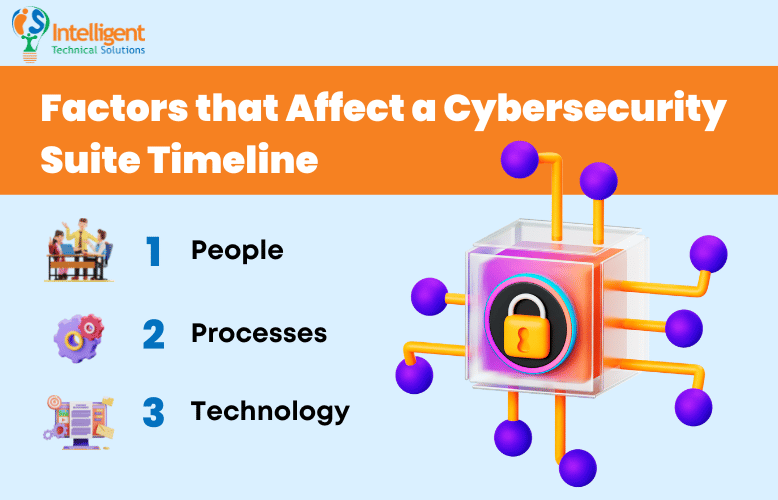How Fast Can a Full Suite of Cybersecurity be Implemented?
January 19th, 2023 | 4 min. read
%20-%202023-01-17T023349.339.jpg)
There has been a significantly increased cost of cyber attacks across global industries. Businesses in the US alone have suffered a whopping $3.6 million loss due to data breaches. Thus, an effective cybersecurity solution is more vital now than ever.
If you’re reading this article, you probably already understand the importance of cybersecurity and are gearing toward implementation. We’re here to help. We’ve talked with Rob Schenk, ITS’ Chief Experience Officer, to let us in on the key things you need to know when carrying through a full suite of cybersecurity.
At ITS, we’ve been helping hundreds of clients strengthen their cybersecurity by managing their IT. In this article, we’ll go over:
- What factors affect a cybersecurity program timeline?
- Steps to follow when implementing a cybersecurity program
After reading, you should be able to create your own cybersecurity program to help protect your assets and other critical information.
What factors affect a cybersecurity suite timeline?
According to Schenk, the timeline depends on the type of cybersecurity you want to implement.

Setting up a formal information security program that requires executive-level buy-in, a team from your side and your Managed IT must first work together to craft a security program that effectively creates a security-first culture within your organization. And that, in itself, takes months–even years.
Although, Schenk cleared that there is no exact estimate of how long the cybersecurity implementation process is.
To start, there are three components you need to sort out: people, processes, and technology.
People
Firstly, you’re trying to ensure that the people have undergone security awareness training programs. Your team members must undergo appropriate training to recognize what a phishing attempt is, for example, or what signs to look for, like strange behavior or strange vents that might clue a user in that there might be a problem.
Following this, you also need to create a culture of communication where if users see something going on, they will quickly bring it up to IT or leadership’s attention. Schenk said that having the right person handle it at the right time can help reduce the impact of an event. Because the sooner you identify the problem, the sooner you can do something about it.
Processes
Next up, you have the processes. This is everything related to how you handle certain procedures, checks and balances. You need to make sure that when something comes up, everyone in the team knows
- Who does what,
- Who communicates with whom,
- When not to do something, and
- When to escalate.
Your team must also know what the expected norms are. As such, things outside of these norms should be paused, reviewed, and escalated before doing anything.
Technology
Lastly, you have your technology. These are the tools, different software product packages, or solutions that you might implement that collectively work together to create a robust security program that will provide the best opportunity to protect the business and all of its critical assets and data.
So, as far as the question goes, how quickly does it take to roll all that out? Schenk cleared that, “It’s a journey, first off.”
It’s not like saying, “Hey, I want to start a cybersecurity program,” and then having it in place first thing tomorrow. It’s a process, and it’s a journey. But it really starts with good fundamentals, including:
- Keeping up to date with patching
- Making sure you have two-factor (2FA) or multi-factor authentication (MFA)
- Ensuring an efficient cybersecurity training
- Having some sort of a managed detection and response (MDR) solution that alerts you if there’s an issue or an attack
If you have all these components taken care of, then that makes it easier for you to implement a new cybersecurity program.
8 Steps to Follow When Implementing an Excellent Cybersecurity Program
While there isn’t a standard timeline when implementing a new cybersecurity program, small to medium-sized businesses can follow these eight steps approach to build the program from the ground up successfully:
1. Conduct a security risk assessment
 A risk assessment determines the assets that could be affected by a cyberattack within your organization, such as hardware, systems, laptops, customer data, and intellectual property. This step is important to help your business understand and prepare for potential attacks and their impact.
A risk assessment determines the assets that could be affected by a cyberattack within your organization, such as hardware, systems, laptops, customer data, and intellectual property. This step is important to help your business understand and prepare for potential attacks and their impact.
2. Select a cybersecurity framework
 After conducting a risk assessment, you can select the most appropriate cyber security framework to mitigate the risks in accordance with the risk assessment findings. Your chosen cyber security framework will serve as an advisory for best practices while designing and implementing policies and controls.
After conducting a risk assessment, you can select the most appropriate cyber security framework to mitigate the risks in accordance with the risk assessment findings. Your chosen cyber security framework will serve as an advisory for best practices while designing and implementing policies and controls.
The National Institute of Standards and Technology (NIST) Cybersecurity Framework consists of guidelines that most government organizations use when assessing and managing cybersecurity risks. Although not required, you may follow this framework to ensure the highest cybersecurity standard.
3. Develop a cybersecurity strategy
 A cybersecurity strategy is a roadmap that establishes a company’s cybersecurity plans in the long run. Planning ahead can ensure that defensive security remains consistently resilient to emerging threats and risks over time.
A cybersecurity strategy is a roadmap that establishes a company’s cybersecurity plans in the long run. Planning ahead can ensure that defensive security remains consistently resilient to emerging threats and risks over time.
4. Develop a risk management plan
 Having a comprehensive risk management plan enables you to see ahead of potential risks and reduce their negative impact on your business’s health.
Having a comprehensive risk management plan enables you to see ahead of potential risks and reduce their negative impact on your business’s health.
5. Create security policies and controls
 Next up, you should be able to decide on the policies and controls that will help define your program’s standard operating procedures (SOP). Your SOP will guarantee that the best practices of the selected cybersecurity framework are applied and remain active.
Next up, you should be able to decide on the policies and controls that will help define your program’s standard operating procedures (SOP). Your SOP will guarantee that the best practices of the selected cybersecurity framework are applied and remain active.
6. Secure your network, data, and applications
 When hackers get access to your network and get hold of sensitive information, they can easily impose harm on your business. Therefore, it is crucial to secure all entry points so as not to give these criminals an opportunity to attack.
When hackers get access to your network and get hold of sensitive information, they can easily impose harm on your business. Therefore, it is crucial to secure all entry points so as not to give these criminals an opportunity to attack.
Read: 10 Best Cybersecurity Tips & Practices in 2022 From Experts
7. Test your security posture
 All the steps above are essential to implement a cybersecurity program successfully, but they may go down the drain if you don’t test them. Testing the effectiveness of security controls includes testing production systems for misconfigurations and monitoring to ensure that security configurations are persistent.
All the steps above are essential to implement a cybersecurity program successfully, but they may go down the drain if you don’t test them. Testing the effectiveness of security controls includes testing production systems for misconfigurations and monitoring to ensure that security configurations are persistent.
8. Evaluate and improve program effectiveness
 Finally, you need to evaluate the effectiveness of your program even after a successful implementation. Since the cybersecurity landscape keeps evolving, you can’t be complacent with your program and must continually monitor what needs improvement.
Finally, you need to evaluate the effectiveness of your program even after a successful implementation. Since the cybersecurity landscape keeps evolving, you can’t be complacent with your program and must continually monitor what needs improvement.
Need help implementing cybersecurity?
Overall, implementing cybersecurity is something that you start where you are–the fundamentals. You start with filling in the gaps, tightening your defenses, and as time goes on, it just gets broader. The end result is that you’re going to create a security-first mindset organization that collectively works to keep your data safe.
It is challenging to deploy a perfect cyber security system all in one go. At ITS, we understand that there are steps in strengthening your security measures. So as an MSP, we will assist you in improving your security one step at a time. Download our FREE cybersecurity checklist to help you create a comprehensive plan for protecting your business against attacks.
Jess is a Content Writer who commits herself to creating helpful, relevant, and easy-to-digest technical articles. When she isn't writing, she devotes her energy (and money) to collecting K-Pop photo cards, which she likes to call an 'investment.'
Topics:
